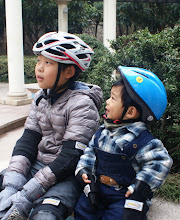I respect all religions. I like to visit old churches in Europe and like to see old temples in Taiwan and China. I believe all religions are good to the world, unless someone distorts its spirit and meanings.
We went to a Buddhist Scenic Park last Sunday. More than 1,300 years ago, there was a popular Buddha temple in Lingshan Mountain. However, after the rampage of wars and culture revolution, this cultural heritage was damaged. The government rebuilt this place in 1994 and reopened it to the public. They added some more statues and "Buddha Palace". After visiting the place, I feel that nowadays Lingshan Buddha Park is of more artistic value than its religious value. The interesting thing is that in traditional Chinese Buddha center, there was no "palace", but we saw one of the major scenic spot called "Buddha Palace"(pictures will be shown in next post). And the instruction in our ticket and in their official website only emphasized the size of the place and statues but did not mention any origin of the idea of the "palace" and some of the "foreign-looked statues". I don't feel comfortable about someone using other's idea without mentioning it. To my knowledge, I think the idea of the "Palace" was from Hindu (India). Traditional Chinese Buddha buildings are temples not palaces. And the fact that Buddhism originate from India can't be denied. Moreover, a Buddha Park or any religious center usually should be built by the followers not built and operated by the government. But to make myself feel comfortable with this visit, I treated the park as a museum of Buddhist Art, Culture and Architecture, instead of a pure religious center. And because the place was built by the government, we can see how rich the government is to build such a spectacular place to attract so many visitors. So I had enjoyed the trip and like to share many pictures we took in this visit.
星期日我们去了久闻其名的靈山。
無锡靈山,位于太湖之濱,风景如画。一千三百多年前,唐代著名高僧玄奘法师,观此山形类似天竺的佛教圣地靈鹫山,因此授记留名。始建为靈山庵,宋时改名为祥符禅寺。後历经战乱,盛况不复。1994年当地政府重建靈山,於禅寺东方加入了大佛像、梵宫,並於景区入口处建了九龍灌柱,原来的佛教勝地,如今观光艺术价值似乎大于其宗教意涵,加上此地的宗教住持和尚们,通常是官派的(不知靈山是否也是如此)。而我也就就抱着观光的心情来到靈山,欣赏这世界最大的佛像与金璧辉煌的梵宫(梵宫的部分放在下一篇,敬请期待)。
雖然是抱着观光的心情来靈山,不知是秋高气爽的关系,还是此地真有靈气,逛完靈山勝地,喝下八功德水,精神舒爽,回頭看到大佛望着我们的背影離去,有點依依不捨。
The Entrance
入口能看到主要景观了
On the top of the Sculptured Pillar, is a Baby Buddha covered by lotus leaves.
柱子上方的莲花包着佛陀太子
Nine Dragons around the Sculptured Pillar( will eject water to bath the baby Buddha)
九龍围绕着即将降生的小佛陀
The lotus on the top is open.
Baby Buddha turns 360 degree around while Nine Dragons are bathing him.
九龍灌浴,过程中小佛陀会绕行360度
After the bathing show, drinking water will flow out through the fire bird's peak.
Visitors line up to gather "purified" water.
表演完後,接饮凤凰嘴出来的八功德水
Buddhist Scriptures written on the Cylinders on the side way.
When visitors touch and turn the Cylinders, that means they read the Scriptures.
108个转轮,每个转轮上刻着经文,转一次表示读了一遍
Sculptures of Vanquishing Demons and attaining the Enlightenment
According to the costumes and layouts, the sculptures are more like Hindu style than traditional Chinese style.
降魔朝聖图
Statue of One hundred kids teasing Maitreya.
Maitreya is a happy Buddha representing Wealth and Fortune.
彌勒佛像
百子戲彌勒
The biggest Buddha's Right Palm in the world.
Touching the palm will brings you longevity.
佛手=福壽,摸摸佛手添福壽
The more than 1,400 year-old Gingko Tree
1,400年的银杏老树
Now, Ready to Climb up to the Biggest Buddha?
还那麽高,只好请Richy带表我们爬上去啦!
Buddha's Feet
We sent Richy to climb up and take this picture.
此时只有爬得上去的人才能“抱佛脚”哦!
There are Buddhist Cultural exhibitions in the hall under the footbase of the Grand Buddha.
大佛脚下是个文物馆
Buddha scriptures and the 500 hundred Disciples
500 羅漢的壁雕和经文
To be continued~








沒有留言:
張貼留言